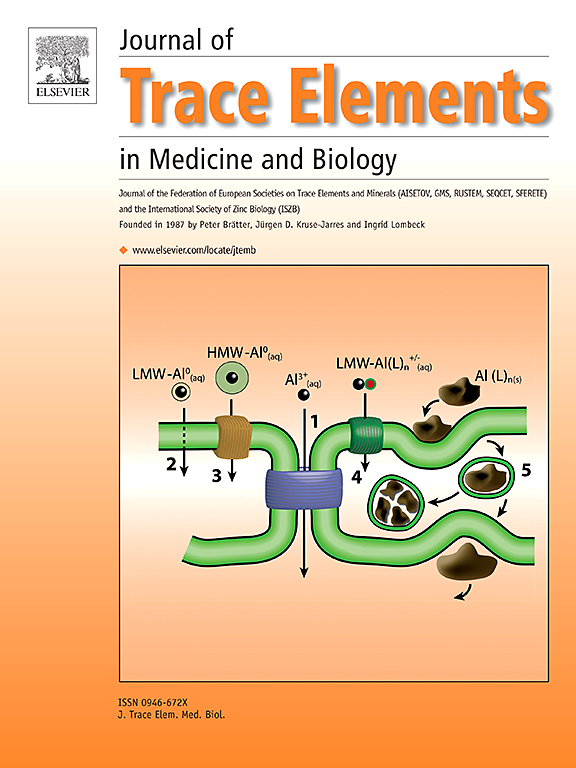Cord-blood levels of heavy metals, vitamin D and calcium and the occurrence of development defects of enamel in primary incisors: A birth cohort study
IF 3.6
3区 医学
Q2 BIOCHEMISTRY & MOLECULAR BIOLOGY
Journal of Trace Elements in Medicine and Biology
Pub Date : 2025-06-28
DOI:10.1016/j.jtemb.2025.127691
引用次数: 0
Abstract
This study investigated the influence of vitamin D, calcium and heavy metals on the frequency of development defects of enamel (DDE) in primary incisors of infants. Serum levels of vitamin D, calcium, arsenic, cadmium, lead, and mercury in cord blood, as well as prenatal and perinatal data, were collected during pregnancy, at birth, and in follow-ups with newborns and infants ≤ 24 months. This was done using laboratory exams, interviews, and newborns’ and infants’ records. An examiner performed dental exams using the Modified DDE. DDE type, color, location, and severity were evaluated, and logistic multiple regression models were analyzed (p < 0.05). Of the infants (n = 306), 52.3 % were boys; 14.4 % were premature; 93.0 % were born to mothers taking medication, 89.9 % to mothers taking vitamin supplements, 38.1 % to mothers who used alcohol, and 11.4 % to mothers who used tobacco. Most newborns had normal weight (88.9 %), adequate size for gestational age (88.1 %), 1-minute APGAR score ≥ 7 (88.6 %), and were exclusively breastfed at discharge from maternity (90.6 %). Arsenic ≥ 0.23 µg/L (53.4 %), cadmium < 0.20 µg/L (52.6 %), lead ≥ 0.8 µg/dL (60.5 %) and mercury ≥ 0.8 µg/L (55.2 %) were found in this population. Most had normal vitamin D (52.6 %) and calcium (76.3 %) levels. The incidence of DDE in infants was 27.1 % (83/306). The number of DDE per child ranged from 1 to 8 with demarcated opacity being the most common defect, while upper central incisors and the incisal third were the teeth and location most affected, respectively. Lead was associated with DDE in primary incisors, except in cases of pregnant women taking vitamin supplements and when the newborn, at the time of discharge, was being breastfed. In the present population, high cord blood levels of lead were associated with the occurrence of DDE in primary incisors.
脐带血重金属、维生素D和钙水平与初级门牙牙釉质发育缺陷的发生:一项出生队列研究
本研究探讨了维生素D、钙和重金属对婴幼儿切牙牙釉质发育缺陷(DDE)发生率的影响。在怀孕期间、出生时以及对新生儿和≤ 24个月的婴儿进行随访时,收集脐带血中维生素D、钙、砷、镉、铅和汞的血清水平,以及产前和围产期数据。这是通过实验室检查、访谈和新生儿和婴儿记录来完成的。审查员使用改良DDE进行牙科检查。评估DDE的类型、颜色、位置和严重程度,并分析logistic多元回归模型(p <; 0.05)。在婴儿中(n = 306),52.3% %是男孩;14.4 %早产儿;93.0 %的孩子是由服用药物的母亲所生,89.9% %的孩子是由服用维生素补充剂的母亲所生,38.1% %的孩子是由饮酒的母亲所生,11.4 %的孩子是由吸烟的母亲所生。大多数新生儿体重正常(88.9 %),胎龄大小合适(88.1 %),1分钟APGAR评分≥ 7(88.6 %),出院时全母乳喂养(90.6 %)。砷≥0.23 µg / L(53.4 %),镉& lt; 0.20 µg / L(52.6 %),导致≥0.8 µg / dL(60.5 %)和水星≥0.8 µg / L(55.2 %)被发现在这个人口。大多数人的维生素D(52.6% %)和钙(76.3% %)水平正常。婴儿DDE发生率为27.1% %(83/306)。每个儿童的DDE数量从1到8不等,其中有界不透明是最常见的缺陷,而上中切牙和切三牙分别是受影响最严重的牙齿和部位。除了孕妇服用维生素补充剂和新生儿在出院时接受母乳喂养的情况外,铅与初级门牙中的DDE有关。在目前的人群中,高脐带血铅水平与初级门牙DDE的发生有关。
本文章由计算机程序翻译,如有差异,请以英文原文为准。
求助全文
约1分钟内获得全文
求助全文
来源期刊
CiteScore
6.60
自引率
2.90%
发文量
202
审稿时长
85 days
期刊介绍:
The journal provides the reader with a thorough description of theoretical and applied aspects of trace elements in medicine and biology and is devoted to the advancement of scientific knowledge about trace elements and trace element species. Trace elements play essential roles in the maintenance of physiological processes. During the last decades there has been a great deal of scientific investigation about the function and binding of trace elements. The Journal of Trace Elements in Medicine and Biology focuses on the description and dissemination of scientific results concerning the role of trace elements with respect to their mode of action in health and disease and nutritional importance. Progress in the knowledge of the biological role of trace elements depends, however, on advances in trace elements chemistry. Thus the Journal of Trace Elements in Medicine and Biology will include only those papers that base their results on proven analytical methods.
Also, we only publish those articles in which the quality assurance regarding the execution of experiments and achievement of results is guaranteed.

 求助内容:
求助内容: 应助结果提醒方式:
应助结果提醒方式:


